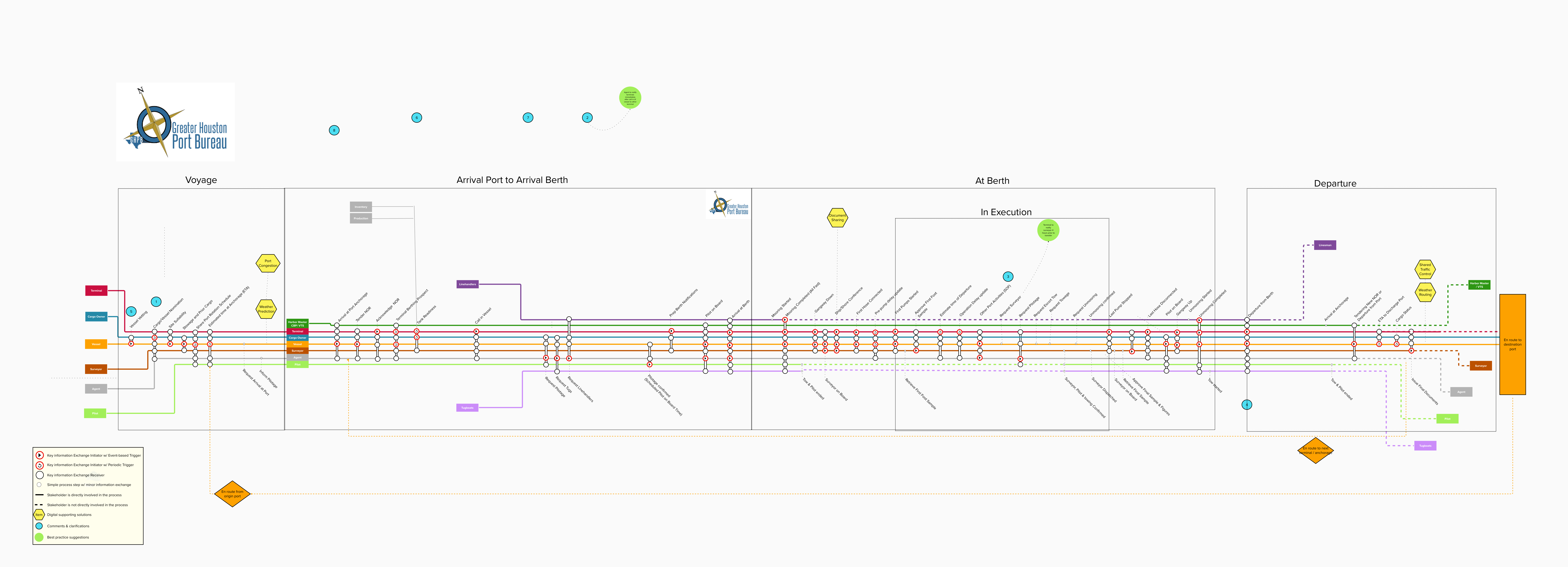Standardized Marine Surveyor Communications Can Improve Port Call Efficiency

Port calls are complex and involve many stakeholders working in close collaboration. A major factor in the overall efficiency of a port call lies in the pre-arrival communications. A weak spot the Greater Houston Port Bureau’s Efficiency Committee has identified in these pre-arrival communications involve marine surveyors, particularly with liquid cargoes.
A marine surveyor is a professional that inspects, witnesses, and certifies cargo transfers. They often serve as an independent third-party performing certification of the cargo operation, and their activities may include cargo sampling and gauging, analysis, witnessing key cargo operations events, assessing tank cleanliness and fitness for purpose, and creating official documentation/certification of the transfer that is often included in official export/import documentation packages.
As a key participant in ensuring the safety, quality, and quantity of cargo operations, good communication is foundational to ensuring surveyors can plan and perform their services without causing delays and/or work to be redone.
Most calls in the port of Houston are facilitated using traditional tools such as emails and phone calls. This article focuses on centralizing communications via email, with a view to designing the underlying processes, flows, and data message suggestions to be adaptive to more sophisticated digital systems. More systematic and real-time exchanges of quality/targeted data is the biggest, most cost-effective lever available to improve efficiency. A well-disciplined communication standard consisting of standard datasets and standard timing/refresh rates is possible regardless of the communication method.
To accomplish these communications goals, definitive datasets and timing/refresh rates need to be established with stakeholders and their internal operations. Because every communication has at least one sender and one receiver, both parties have responsibility to make the data exchange more effective and efficient. In many cases, working jointly with stakeholder partners to do this kind of assessment can bring significant value and insight.
 Note: The port call process map (also known as the "subway map") can be found on the Port Bureau's website by clicking here.
Note: The port call process map (also known as the "subway map") can be found on the Port Bureau's website by clicking here.
Significant communication steps to standardize include:
Cargo/vessel nomination: This communicates the main aspects of the cargo transfer and services needed. It serves as the order or service contract. A best practice is for charterers/cargo owners to standardize product handling specifications, analytical specifications, physical property information, safety data sheets, etc., and make those documents available via a web portal or API connection.
Berthing prospects: The communicates an estimation or schedule of when a vessel can be berthed. This is sometimes communicated per vessel or as part of a regularly published schedule. This information allows the surveyor to check for changes and adjust manpower and equipment planning.
Pre-boarding request (vessel): Communicates essential information regarding the upcoming cargo operation.
Pre-boarding request (terminal): Communicates key information regarding the upcoming cargo operation. In addition to information related to line-ups, additives, transfer details, etc., it also communicates information related to tank readiness.
Call in vessel: Terminal communication instructing the vessel that the terminal is ready for the vessel to call. This data exchange triggers discussions related to re-checking tank readiness and exchanging data related to shore line-ups.
Prep berth notification: Terminal providing notice to the surveyor that the vessel will be arriving within the next 4 to 8 hours. This data exchange provides instructions and details about the vessel’s arrival, transfer details, and special instructions.
Pilot onboard: Notification that the pilot is onboard. This message is likely to come in roughly the same time frame as the prep berth message and serves as a secondary confirmation that the vessel is headed to the terminal and will be there within hours.
Arrival at berth: Notification that the vessel has arrived. In many cases, if the above communications were completed appropriately, the surveyor will be ready onsite. This communication should serve as a confirmation for tracking, not as a primary message.
In each communication step, data in the subject line information and formatting, the distribution list, and timing should be standardized. Data exchanges that have no relevance to the surveyor should be eliminated to reduce the overall email load on the surveyor. These may include communications such as acknowledge NOR or requests for pilotage, tugs or line handlers.
Because of the pace and dynamics of marine operations in the port of Houston combined with the lack of communication standards among stakeholders, key participants may receive information for the same cargo transfer from multiple sources at different times. This can needlessly double, triple, or even quadruple the number of communications key focal points need to manage.
To compensate, many port stakeholders revert to phone conversations. While this methodology has an element of effectiveness, the overall result is negative. Conducting “the real” business by phone is both time consuming and inefficient as the conversation is between only two people, when it may be that several stakeholders need the same information.
Optimal solutions to the above would include tenants such as:
- Only impacted stakeholders are part of the data exchange, and the data exchange informs impacted stakeholders directly and at the same time.
- Messages are set up so that the timeliest communications receive the top priority.
- Timely communications are confirmed, read, and actioned so the sender has confidence that the issue has received the requisite attention.
- The owner of the most accurate data is the data source so only the best, timeliest data is shared.
- Messages deemed as the key data are standardized so they are easy to consume and provide complete information.
- Where digital systems are connected, the connection/systems are configured to alert participants when connections are broken, data exchanges fail, and/or when data exchanges contain data that requires immediate and/or priority action.
Companies on the sending side of key data exchanges are encouraged to consider things like:
- Are there any unnecessary communications? If not, can communications be turned off or sent deprioritized?
- How can the data exchange format be further standardized? For example, standard data formatting in the body of the message, consistent formatting in the subject line, and consistent usage of the agreed communication tool can contribute to easier ingestion on the receiving side (up to and including enabling automated ingestion options for the receiver).
- Where digitized systems already exist, can they be tailored to automatically send key data exchanges at the right time to the right stakeholders?
Companies on the receiving side of key data exchanges are encouraged to consider things like:
- Who is receiving these communications? For instance, once the key data exchange is received, how is the information distributed within the receiving organization to the other stakeholders who might also need to know that information?
- For the person(s) receiving the data exchanges, are they equipped with the necessary tools and training that enable prioritization of the most important data exchanges?
- How is the data exchange tracked and logged? Data exchanges should inform a centralized system of record that allows for further communication, visibility, analysis, historical reporting, etc.
- How can lag times between receipt of the data exchange and population of the system of record be minimized?
- Where digitized systems exist, can they be tailored to ingest and alert on standardized messages being received?
- Are there additional technologies such as repetitive process automation, AI, API, etc., that might help to ingest and process incoming data exchanges?
Efficiency is a journey involving many stakeholders. If you or your company would like to participate in discussions leading to greater efficiency in marine surveyor communications, please reach out to the Greater Houston Port Bureau, Christine Schlenker at cschlenker@txgulf.org.
